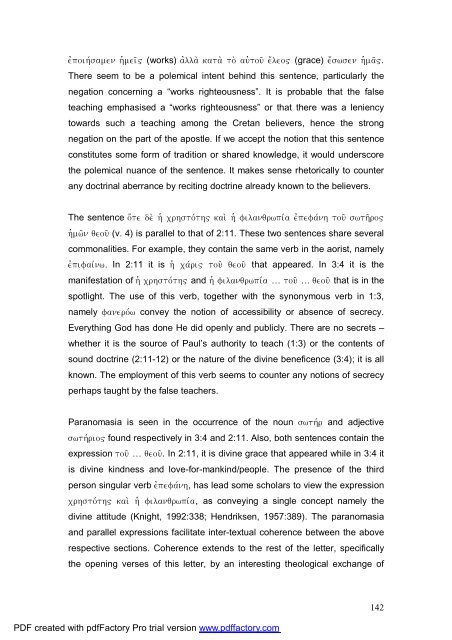A Text centred rhetorical analysis of Paul's Letter to Titus
A Text centred rhetorical analysis of Paul's Letter to Titus
A Text centred rhetorical analysis of Paul's Letter to Titus
Create successful ePaper yourself
Turn your PDF publications into a flip-book with our unique Google optimized e-Paper software.
ejpoihvsamen hJmei`" (works) ajlla; kata; <strong>to</strong>; auj<strong>to</strong>u` e[leo" (grace) e[swsen hJma`".<br />
There seem <strong>to</strong> be a polemical intent behind this sentence, particularly the<br />
negation concerning a “works righteousness”. It is probable that the false<br />
teaching emphasised a “works righteousness” or that there was a leniency<br />
<strong>to</strong>wards such a teaching among the Cretan believers, hence the strong<br />
negation on the part <strong>of</strong> the apostle. If we accept the notion that this sentence<br />
constitutes some form <strong>of</strong> tradition or shared knowledge, it would underscore<br />
the polemical nuance <strong>of</strong> the sentence. It makes sense <strong>rhe<strong>to</strong>rical</strong>ly <strong>to</strong> counter<br />
any doctrinal aberrance by reciting doctrine already known <strong>to</strong> the believers.<br />
The sentence o{te de; hJ crhs<strong>to</strong>vth" kai; hJ filanqrwpiva ejpefavnh <strong>to</strong>u` swth`ro"<br />
hJmw`n qeou` (v. 4) is parallel <strong>to</strong> that <strong>of</strong> 2:11. These two sentences share several<br />
commonalities. For example, they contain the same verb in the aorist, namely<br />
ejpifaivnw. In 2:11 it is hJ cavri" <strong>to</strong>u` qeou` that appeared. In 3:4 it is the<br />
manifestation <strong>of</strong> hJ crhs<strong>to</strong>vth" and hJ filanqrwpiva … <strong>to</strong>u' … qeou` that is in the<br />
spotlight. The use <strong>of</strong> this verb, <strong>to</strong>gether with the synonymous verb in 1:3,<br />
namely fanerovw convey the notion <strong>of</strong> accessibility or absence <strong>of</strong> secrecy.<br />
Everything God has done He did openly and publicly. There are no secrets –<br />
whether it is the source <strong>of</strong> Paul’s authority <strong>to</strong> teach (1:3) or the contents <strong>of</strong><br />
sound doctrine (2:11-12) or the nature <strong>of</strong> the divine beneficence (3:4); it is all<br />
known. The employment <strong>of</strong> this verb seems <strong>to</strong> counter any notions <strong>of</strong> secrecy<br />
perhaps taught by the false teachers.<br />
Paranomasia is seen in the occurrence <strong>of</strong> the noun swthvr and adjective<br />
swthvrio~ found respectively in 3:4 and 2:11. Also, both sentences contain the<br />
expression <strong>to</strong>u` … qeou`. In 2:11, it is divine grace that appeared while in 3:4 it<br />
is divine kindness and love-for-mankind/people. The presence <strong>of</strong> the third<br />
person singular verb ejpefavnh, has lead some scholars <strong>to</strong> view the expression<br />
crhs<strong>to</strong>vth" kai; hJ filanqrwpiva, as conveying a single concept namely the<br />
divine attitude (Knight, 1992:338; Hendriksen, 1957:389). The paranomasia<br />
and parallel expressions facilitate inter-textual coherence between the above<br />
respective sections. Coherence extends <strong>to</strong> the rest <strong>of</strong> the letter, specifically<br />
the opening verses <strong>of</strong> this letter, by an interesting theological exchange <strong>of</strong><br />
PDF created with pdfFac<strong>to</strong>ry Pro trial version www.pdffac<strong>to</strong>ry.com<br />
142

















